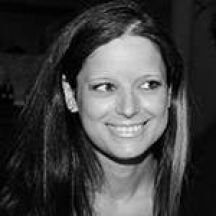Ever since its invention back in the 18th century, photography has been documenting life. At the same time, it focuses on inviting audiences to a rather subjective world while trying to be taken seriously as an art form. Photography has always been considered a male dominated profession, but luckily things are changing. Scholars, writers, bloggers, photography students and enthusiasts have been giving due to the female pioneers of the field. Most of them were always standing and/or hiding in the shadows, oblivious to how much they could acclaim and accomplish. Arguably, the technique, concepts and themes female photographers use, differ from those of male photographers. When most women were convinced that their place was in the kitchen and certainly not in the dark room, there were those who were struggling to surpass their male counterparts and work towards gaining respect and recognition for their work.
I was the only woman fooling around with a camera in the streets and all the reporters laughed at me. So I became a fighter.
• Lola Álvarez Bravo (Mexican photographer, 1903-1993) was a key figure in the post-revolution Mexican renaissance and well known for her image composition skills. Her peers considered her work to be fine art and her surreal documentation of Mexico’s people, cities, and villages were her trademark. She became Manuel Álvarez Bravo’s darkroom assistant, after she married him and then took on a solo career when they separated. Beginning her career as a teacher, Álvarez took photographic assignments for magazines and newspapers, developing a reputation as one of the only women photojournalists working in Mexico City. She later opened an art gallery to promote her works and those of her friends. Álvarez Bravo continued her photography work until the late 1980’s, when she started losing her sight. She died in Mexico City in 1993. Today, her photographs are held in the collections of The Museum of Modern Art in New York, the National Museum of Women in the Arts in Washington, D.C. and the J. Paul Getty Museum in Los Angeles, among others.

• Margaret Bourke-White (American photographer, 1904-1971) lived the life that most photographers only dream about. During her youth in the Bronx, her father was very fond of photography and was always experimenting with lenses and other gadgetry. It was only after his death though, that Margaret decided to pick up a camera. In 1921, she enrolled in classes at Columbia University in New York to study art, but ended up attending 7 different Universities and acquiring 6 different degrees. After making arrangements with a commercial photographer to use his darkroom for a school project, Bourke-White made her first step to become a photographer. In 1928, she started a commercial photography studio and began concentrating on architectural and industrial photography. In 1929 she was already working as a photojournalist for Fortune magazine and in 1936 she was hired as the first female photojournalist for Life magazine. Bourke-White continued to photograph even after she was diagnosed with Parkinson’s in 1952. She wrote and published several books on her work as well as her autobiography, Portrait of Myself (1963). Her photographs are in the Brooklyn Museum, the Cleveland Museum of Art, the New Mexico Museum of Art and the Museum of Modern Art in New York, as well as in the collection of the Library of Congress. Many of her manuscripts, memorabilia, photographs and negatives are housed in Syracuse University’s Bird Library Special Collections section.
.jpg?type=im&w=133&h=200&s=0c5d8b85b165fb2f2f6db8b9a3bb0f90)
• Ruth Bernhard (German-born American photographer, 1905-2006) was best known for her studio-based practice of photographing nudes. She studied art history and typography at the Academy of Fine Arts In Berlin and in 1927 she moved to New York. By her late 20’s she was deeply involved with the lesbian subculture of the artistic community of Manhattan and her female nudes became her best-known subject. Bernhard was inspired by the small things in her life. In a 1999 interview she stated: “I’m most interested in the little things that nobody observes, that nobody thinks are of any value”. The idea of minimalism drove her passion for photography. She worked with Group f/64 and later as a commercial photographer, almost exclusively in black and white. She ventured into publishing in 1986 with her book of black and white portraits, The Eternal Body. She was inducted into the National Women’s Caucus for Art in 1981 and worked with the filmmaker Robert Burrill on an autobiographic film entitled Illuminations: Ruth Bernhard, Photographer, which premiered in 1989.
• Regina Relang (German fashion photographer and photojournalist, 1906-1989) was active during the 1950’s and 1960’s and mostly documented the latest designs of prominent fashion houses. Her entire family was artistic and her introduction to the world of fashion came after she befriended fashion photographer Willy Maywald and moved to Paris. Relang began working for Vogue in 1938, publishing photographs in the French, American, and British editions. Her work was also regularly used in many other fashion magazines and over the course of her career, she photographed the women’s fashion of Christian Dior, Pierre Cardin and Yves Saint-Laurent. Her photographs are known for their elegance, glamour and use of lifelike settings that contrast with the designs being showcased.







